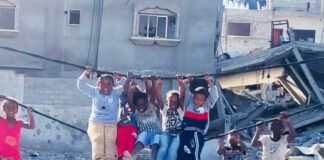by Wanda Sabir
Though the story of incarceration is always hard, it is more sobering when those affected are children. What if those youth convicted had an opportunity to reimagine their lives and interrupt and rewind the script? What would the scenario look like? Who would star in the feature?

The Compound, where LA County boys are held, is a jail within a jail at Sylmar Juvenile Hall in Chino, San Bernardino County. The boys are separated from general population for the severity of the violent crime they are convicted of; nonetheless, they are still kids: playful, immature and filled with regret but without the inherent gravity that comes with maturity.
The boys don’t seem to grasp what these pending sentences mean. What does 25 years, not to mention 90 years feel like to someone so young? It is incomprehensible. Sentencing children as adults for violent crime in this population is misdirected. Why not put the investment in the public sector: better public schools, before- and after-school programs, housing and job training and skill development for parents?
Instead, the boys and girls end up at Sylmar in The Compound. We see one participant get shipped off to an adult prison. We meet his father, who shares a letter where the child describes the roaches and other vermin in the cell he shares with a 50-year-old man. The boy writes, “I would cry, but I can’t do that in here.” Instead, his dad cries.
Sentencing children as adults for violent crime in this population is misdirected. Why not put the investment in the public sector: better public schools, before- and after-school programs, housing and job training and skill development for parents?
The children who end up in The Compound have witnessed violence or been victims of violence. One father shares his son’s witnessing his attempted suicide. He’d stabbed himself twice and was about to stab himself again when the child approached. Another boy witnesses a shooting. The person right next to him is shot multiple times in the head and body.
“Monsters” centers on the workshop with Gabriel Cowan and the boys who over a period of months write a screenplay. Later, professional actors are brought into the workshop, and the film is shot; however, included in this film are also the stories of the boys and their families. “Monsters” is a film within a film. The embedded work is the boys sharing their vision of change and what they wish for other youth faced with similar choices.
The work has a profound effect on the film teams’ lives. From their first meetings in 2013 to now, the advocacy and involvement continues. At the time the film is shot, a lot of legislation affecting juveniles (14-17) in the criminal justice system was being debated, especially Senate Bill 9 (2012) which eliminated the “life without the possibility of parole” sentences for (most) juvenile offenders. SB 260 (2013) provides parole hearings at 15 or 25 years for juveniles with de facto life sentences who were under 18 when they were sentenced. Lastly, SF 261 (2015) raises the age of eligibility for SB 260 to young people sentenced when they were under 23 years old.
“Monsters” centers on the workshop with Gabriel Cowan and the boys who over a period of months write a screenplay.
“They Call Us Monsters” is unprecedented in the access Lear is allowed. His access to the boys and their legal documents was directly connected to whose court the boys were property of. We are in the court when Jarad is tried and sentenced. We also see archived film of his interrogation, where he admits to being the shooter in the altercation which leaves a victim paralyzed. He even writes a note to the victim apologizing for his role in the altercation.
Antonio, the youngest of the three, has so much promise. He shows Jarad his awards for academic achievement – he can do anything. We meet the families of the boys and their siblings, even victims. Lear’s camera takes us on an intimate journey. The boys seem trapped by circumstances beyond their control; however, “Monsters” shows both its audience and protagonists that even when captured, the prisoner has agency and options. This is what we see in the screenplay the boys write.
The reception the film met when screened at The Compound validates the role art can have in rehabilitation. The boys are pleased and so are their peers. Lear, who stays in contact with the three boys, also now volunteers as a teacher with InSide Out Writers, one of the collaborators with the team. California, Lear says, has more legislation directed at its youth and true rehabilitation over incarceration than any other state.
Bay View Arts Editor Wanda Sabir can be reached at wanda@wandaspicks.com. Visit her website at www.wandaspicks.com throughout the month for updates to Wanda’s Picks, her blog, photos and Wanda’s Picks Radio. Her shows are streamed live Wednesdays at 7 a.m. and Fridays at 8 a.m., can be heard by phone at 347-237-4610 and are archived at http://www.blogtalkradio.com/wandas-picks.

 Store
Store



